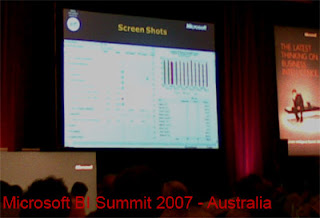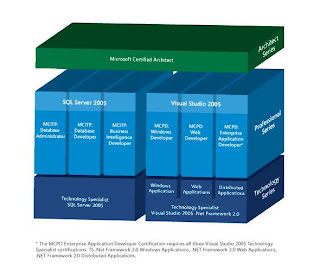I found these links very helpful:
08 December 2007
MCITP – Business Intelligence Developer (Exam: 70-446)
07 December 2007
Slowly Changing Dimension (SCD)
- Type 1 (overwrites the original information) (http://www.1keydata.com/datawarehousing/scd-type-1.html)
- Type 2 (a new record is added to the table to represent the new information, keeps all historical information) (http://www.1keydata.com/datawarehousing/scd-type-2.html)
- Type 3 (keeps original value, and current value in different columns of the same record) (http://www.1keydata.com/datawarehousing/scd-type-3.html)
- Type 4: uses "history tables", where one table keeps the current data, and an additional table is used to keep a record of some or all changes
- Type 6 (2+3+1) (hybrid approach that combines the three fundamental SCD techniques)
Note: SSIS SCD control only supports Type1 and Type2. But by identifying columns with the fixed attribute update type, you can capture the data values that are candidates for Type 3 changes.
- Slowly Changing Dimension Transformation (http://msdn2.microsoft.com/en-us/library/ms141715.aspx)
- Configuring Outputs Using the Slowly Changing Dimension Wizard (http://technet.microsoft.com/en-us/library/ms141662.aspx)
- http://en.wikipedia.org/wiki/Slowly_changing_dimension
| Slowly Changing Dimension Transformation Outputs | ||
| Output | Description | Data flow requirements |
| Changing Attributes Updates Output | The record in the lookup table is updated. This output is used for changing attribute rows. | An OLE DB Command transformation updates the record using an UPDATE statement. |
| Fixed Attribute Output | The values in rows that must not change do not match values in the lookup table. This output is used for fixed attribute rows. | No default data flow is created. If the transformation is configured to continue after it encounters changes to fixed attribute columns, you should create a data flow that captures these rows. |
| Historical Attributes Inserts Output | The lookup table contains at least one matching row. The row marked as “current” must now be marked as "expired". This output is used for historical attribute rows. | Derived Column transformations create columns for the expired row and the current row indicators. An OLE DB Command transformation updates the record that must now be marked as "expired". The row with the new column values is directed to the New Output, where the row is inserted and marked as "current". |
| Inferred Member Updates Output | Rows for inferred dimension members are inserted. This output is used for inferred member rows. | An OLE DB Command transformation updates the record using an SQL UPDATE statement. |
| New Output | The lookup table contains no matching rows. The row is added to the dimension table. This output is used for new rows and changes to historical attributes rows. | A Derived Column transformation sets the current row indicator, and an OLE DB destination inserts the row. |
| Unchanged Output | The values in the lookup table match the row values. This output is used for unchanged rows. | No default data flow is created because the Slowly Changing Dimension transformation performs no work. If you want to capture these rows, you should create a data flow for this output. |
06 December 2007
Usage-Based Optimization in Analysis Services 2005
You can optimize partitions of a measure group based on the usage. Here is the full instruction:
http://www.databasejournal.com/features/mssql/article.php/10894_3575751_1
02 December 2007
What is "Microsoft Office PerformancePoint Server 2007"?
"Microsoft® Office PerformancePoint™ Server 2007 is an integrated performance management application that provides robust monitoring, analytics, and planning capabilities. Office PerformancePoint Server 2007 helps businesses to articulate goals; monitor business activity; identify and analyze issues; and collaborate and take action."
PPS is very feature rich. It has all the functionality customers can expect if they need to plan, budget, forecast, scorecard, dashboard their business activities and use management reporting and consolidation. In addition, all users work with a single data model whether they are monitoring, analyzing and planning.
We can’t talk about PPS and don’t mention two names: Adrian Downes and Nick Barclay my ex-colleagues at SDM and PPS gurus. Their books about PPS 2007 have just been published a couple of days ago:
Here are their blogs:
Here are some more useful links about PPS 2007:
- http://office.microsoft.com/en-us/performancepoint/ha102422371033.aspx
- http://www.microsoft.com/business/performancepoint/resources/training.aspx
01 December 2007
Microsoft Office PPS 2007 - beta exam
Some exam topics from our memory (myself and my colleague Lisset):
- Refresh rate Interval - (PPSAddInforExcel.chm)
- Assignment rule, allocation rules - PEL Syntax
- Rule set types and rule types - (PPSPlanningBusinessModelerHelp.chm)
- PSSAddinforExcel.dll
- Review all the help - (PPSAddInforExcel.chm) - is small and there are different questions about it. (e.g. parameters)
- Business Roles – administrative Roles. Very clear what to do which each one. Security and roles - (PPSPlanningBusinessModelerHelp.chm)
- Update member property - (PPSPlanningBusinessModelerHelp.chm)
- Current Time period - (PPSPlanningBusinessModelerHelp.chm)
- Association- (PPSPlanningBusinessModelerHelp.chm)
- Member set- (PPSPlanningBusinessModelerHelp.chm)
- Installing the PPS (Clean Installation)
- Building the Reports, defining filters, show the leaf members, link the reports in worksheet (PPSAddInforExcel.chm)
- Generic models, sub sites, Associations - (PPSPlanningBusinessModelerHelp.chm)
- Workflow, setup roles, modify the existing workflow - (PPSAddInforExcel.chm, PPSPlanningBusinessModelerHelp.chm)
- Creating Data Sources, DSN
- Create an association to move data between models PPSPlanningBusinessModelerHelp.chm)
- Assumption models - (PPSPlanningBusinessModelerHelp.chm)
- Defining a SCOPE statement - (PPSPlanningBusinessModelerHelp.chm)
- Data Integration: Sync the staging DB, Loading data from staging to application database - (PPSPlanningBusinessModelerHelp.chm)
29 November 2007
MS BI Summit 2007 - Melbourne - Australia

Microsoft BI Summit was held in Melbourne on Nov 2007 and it was so interesting for me specially meeting many of my ex-colleagues and clients. The best part was when Sean Downer (Manager - Decision Support, Royal Children's Hospital, Melbourne) presented the RCH BI system as the case study of a successful MS BI system. I was involved on development of that system. They are using SharePoint server to host a dashboard designed by the Business Scorecard Manager (BSM) which includes scorecards and SSRS reports talking to SSAS cubes.
Another exciting session was "PerformancePoint Server 2007: Monitoring and Analyzing", which Nick Barkley (our ex-colleague at SDM) presented the new features of PPS 2007 Monitoring module and how developers can develop the project in their local system without have to deploy it to SharePoint to see the result.
There were some other informative sessions about data mining, MDX and PPS Planning & Budgeting which all had some interesting points.
Last session was presented by David Lean (from Microsoft). He talked about new BI features and new performance improvements in SQL Server 2008.
28 November 2007
Hello World!
3....2.....1.... and now I'm a blogger!
I’m going to share some Business Intelligence stuff I learn in my job and some stuff I learn from life.
If you are a Microsoft fan, you may find some good stuff here, otherwise don't waste your time here!





.png)



